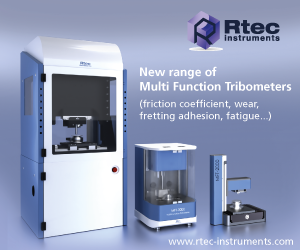Administration of the project
Additive manufacturing using metallic gels
By Dr. Neil Canter, Contributing Editor | TLT Tech Beat November 2023
A solid-liquid-liquid gel has sufficient viscosity to be extruded and then 3D printed.
HIGHLIGHTS
• The liquid metal forms small bridges between copper particles that stabilizes the gel in water.
• Further stressing of the 3D finished metal part has been found to change its shape and is known as 4D printing.
One of the most common methods for additive manufacturing is the use of laser powder bed fusion. In this process, a laser is applied to melt a layer of a specific metal powder in a specific area. A past TLT article1 indicates that a problem associated with laser powder bed fusion is the formation of pores that can shorten fatigue life because they facilitate the formation of fatigue cracks. Researchers generated a power-velocity map in the 3D printing of a titanium alloy to identify regions where pore formation was occurring by varying the power of the laser and the scan speed across the metal surface. Pore formation originated from keyholes present in the molten metal that pinch off and move into the body of the metal under specific process conditions.
Dr. Michael Dickey, the Camille & Henry Dreyfus Professor of chemical and biomolecular engineering at North Carolina State University in Raleigh, N.C., says, “Another challenge with current methods to 3D print metals is the need for high temperatures and expensive equipment. Such high temperatures are needed to fuse the metal powder together and the laser and processing equipment needed to deliver that energy are expensive. We are exploring ways to print metals in a simple manner at room temperature using an extrusion-based process. Doing so is a challenge because most metals, such a copper, have large melting points and thus cannot be extruded from a nozzle since they are solid.”
Utilizing copper metal in additive manufacturing offers the potential for manufacturing metal parts that are conductive. Since copper is a solid at room temperature, it needs to be dispensed from a nozzle as particles suspended in a liquid. But the initial challenge is how to develop an approach for stabilizing the copper in an aqueous environment that can be 3D printed under mild conditions. Dickey says, “When placed in water, copper particles will settle to the bottom of the vessel and ultimately jam the nozzle during printing. In seeking a strategy for stabilizing copper in water, we started working with the liquid metal gallium, which exhibits low toxicity, no vapor pressure and does not evaporate.”
Solid-liquid-liquid gel
The researchers determined that mixing a liquid metal consisting of eutectic gallium indium with copper and water proved to be the answer in developing a solid-liquid-liquid gel that can be used as a 3D printing ink by extrusion through a nozzle. This gel is designated in this manner because copper is the solid, and gallium indium and water are the two liquids.
The presence of liquid metal particles produces small bridges between copper particles because gallium indium is very effective at wetting copper. Optical micro- graphs indicate that in the resulting gel the copper particles are on average 10 micron in diameter while the liquid metal droplets are 25 microns in size.
Dickey says, “Through wetting, the liquid metal can act as a bridge between copper particles to form and stabilize the gel in water. This is analogous to adding a small quantity of water to sand. A similar bridge arrangement enables sand to stick together as a clumpy solid instead of remaining in the form of individual grains.”
Gallium has a surface oxide layer that represents a barrier to the formation of the solid-liquid-liquid gel by restricting the ability of the liquid metal to wet copper. This coating is amphoteric and can be removed either with acid or base. Dickey says, “We conducted a study where the liquid metal, copper and water were mixed at pH values ranging from 0 to 14. The oxide layer is stable between pH values of 3 and 11 but can be removed either with concentrated acid or base. Hydrochloric acid was chosen because it will evaporate during the printing process. In contrast, the base, sodium hydroxide, is a solid and cannot be as easily removed.”
To ensure the liquid gel has sufficient viscosity to be extruded and then 3D printed, the researchers introduced a small quantity of the well-known, rheological modifier, methylcellulose, to the gel. The researchers adjusted the ratio of liquid metal to copper with water to find the optimum ratio to use in the 3D printing process.
Dickey indicates that the initial parts produced can be stressed through applying the solid-liquid-liquid gel to common designs. He says, “The application of stress to change the shape of a 3D printed part is known as 4D printing with the 4th dimensions being time. We found that the anisotropic nature of the ink is amenable to being further stressed during drying to form various shapes by heating the material at an elevated temperature after printing.”
One example is the formation of a Spiderbot sensor shown in Figure 1 that forms a spider shape upon heating at 80 C. This structure is highly conductive and by touching the object, the LED eyes will turn off.
Dickey says, “We intend to better understand the mechanical properties of the solid- liquid-liquid gel in future work. Up to this point, copper has been the only metal used, but we will be evaluating other metals.”
This process demonstrates the ability to use additive manufacturing to produce an object at room temperature with no need for post-processing to render it conductive. It may facilitate the manufacture of a wide range of electronic components and devices.
Additional information can be found in a recent article2 or by contacting Dickey at [email protected].
REFERENCES
1. Canter, N. (2021), “Identification of the source of pore formation in additive manufacturing,” TLT, 77 (2), pp. 12-13. Available here.
2. Xing, R., Yang, J., Zhang, D., Gong, W., Neumann, T., Wang, M., Huang, R., Kong, J., Qi, W. and Dickey, M. (2023), “Metallic gels for conductive 3D and 4D printing,” Matter, 6 (7), pp. 2248-2262.
Neil Canter heads his own consulting company, Chemical Solutions, in Willow Grove, Pa. Ideas for Tech Beat can be submitted to him at [email protected].



Be the first to comment